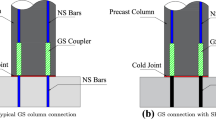Abstract
Using superelastic shape memory alloys (SMAs) as reinforcing bars in concrete structures proved to have a great potential in seismic areas because of its recentering capability. However, using them in an entire structure is generally not economically feasible due to their high cost. Therefore, it is more practical to limit their use to the plastic hinge zones, while regular steel can be used in the other regions of the structure. Connections between SMA and steel are critical, and need to be strong enough to transfer the full force from SMA bars to steel bars. Various mechanical couplers are available in the market to splice bars in reinforced concrete (RC) structures, each of which has several advantages and disadvantages. The efficiency of these couplers for connecting steel bars is tested and reported in this paper. Since these couplers are intended for connecting steel bars only, another experimental investigation has been performed to determine the suitability of these couplers for connecting SMA with steel bars. Commercially available screw-lock couplers are found to be unsuitable for connecting SMA to steel bars. An existing coupler has been modified for SMA–steel splicing to allow SMA bars to achieve their full superelastic strain. Additional tests have also been performed for connecting FRP bars to SMA bars. A new generation mechanical-adhesive type coupler has been developed for splicing FRP to SMA bars.



















Similar content being viewed by others
References
A615/A615M-06a (2007) Standard specification for deformed and plain carbon–steel bars for concrete reinforcement. ASTM International, West Conshohocken
A706/A706M-06a (2007) Standard specification for low-alloy steel deformed and plain bars for concrete reinforcement. ASTM International, West Conshohocken
A996/A996M-06a (2007) Standard specification for rail-steel and axle-steel deformed bars for concrete reinforcement. ASTM International, West Conshohocken
AASHTO LFRD (2004) Bridge design specifications, 3rd edn. American Association of State Highway and Transportation Officials, Washington, DC, 1522 pp
ACI Committee 318 (2005) Building code requirements for structural concrete (ACI 318-05) and commentary (318R-05). American Concrete Institute, Farmington Hills, 430 pp
Alam MS, Youssef MA, Nehdi M (2007) Seismic behaviour of concrete beam-column joints reinforced with shape memory alloys. In: Ninth Canadian conference on earthquake engineering, Ottawa, Canada, 10 pp
Andrawes B, Desroches R (2005) Unseating prevention for multiple frame bridges using superelastic devices. Smart Mater Struct 14(3):S60–S67
Auricchio F, Fugazza D, DesRoches R (2006) Earthquake performance of steel frames with nitinol braces. J Earthq Eng 10(SPEC):45–66
Barsplice Products Inc. (2006) Zap screwlok® mechanical splices and connectors for reinforcing bars—review. April 2006. http://www.barsplice.com/BPI_Scans/Zap_Data-Sheet_RevA.pdf
Bruno S, Valente C (2002) Comparative response analysis of conventional and innovative seismic protection strategies. Earthq Eng Struct Dyn 31(5):1067–1092
Clark PW, Aiken ID, Kelly JM, Higashino M, Krumme R (1995) Experimental and analytical studies of shape-memory alloy dampers for structural control. Proc SPIE 2445:241–251
Coogler KL, Harries KA, Gallick M (2008) Experimental study of offset mechanical lap splice behavior. ACI Struct J 105(4):478–487
Dayton/Richmond Concrete Accessories (2006) Bar-lock coupler system. April 2006. http://www.daytonconcreteacc.com
DesRoches R, Delemont M (2002) Seismic retrofit of simply supported bridges using shape memory alloys. Eng Struct 24(3):325–332
DesRoches R, McCormick J, Delemont M (2004) Cyclic properties of superelastic shape memory alloy wires and bars. ASCE J Struct Eng 130(1):38–46
Dolce M, Cardone D, Marnetto R, Mucciarelli M, Nigro D, Ponzo FC, Santarsiero G (2004) Experimental static and dynamic response of a real RC frame upgraded with SMA re-centering and dissipating braces. In: The proceedings of the 13th world conference on earthquake engineering; paper no. 2878
Hall PC (2003) Laser welding nitinol to stainless steel. In: Proceedings of international conference on shape memory and superelastic technologies, California, pp 219–228
Inaudi JA, Kelly JM (1994) Experiments on tuned mass dampers using viscoelastic, frictional and shape memory alloy materials. Proc 1st World Conf Struct Control 2(TP3):127–136
Indirli M, Castellano MG, Clemente P, Martelli A (2001) Demo-application of shape memory alloy devices: the rehabilitation of the S. Giorgio Church Bell-Tower. Proc SPIE 4330:262–272
Mahin SA (1998) Lessons from damage to steel buildings during the Northridge earthquake. Eng Struct 20(4–6):261–270
Maruyama T, Itoh S, Nishiyama H (1989) Study on bond characteristics of deformed fibre reinforced plastic rods. Proc Jpn Concr Inst 11(1):777–782
McCormick J, DesRoches R (2003) Seismic response using smart bracing elements. In: Proceedings of the extreme loading conference, Toronto
Ocel J, DesRoches R, Leon RT, Hess WG, Krumme R, Hayes JR, Sweeney S (2004) Steel beam-column connections using shape memory alloys. ASCE J Struct Eng 130(5):732–740
Saiidi MS, Wang H (2006) Exploratory study of seismic response of concrete columns with shape memory alloy reinforcement. ACI Struct J 103(3):436–443
Salichs J, Hou Z, Noori M (2001) Vibration suppression of structures using passive shape memory alloy energy dissipation devices. J Intell Mater Syst Struct 12(10):671–680
Tamai H, Miura K, Kitagawa Y, Fukuta T (2003) Application of SMA rod to exposed-type column base in smart structural system. Proc SPIE 5057:169–177
Wilde K, Gardoni P, Fujino Y (2000) Base isolation system with shape memory alloy device for elevated highway bridges. Eng Struct 22:222–229
Youssef MA, Alam MS, Nehdi M (2008) Experimental investigation on the seismic behaviour of beam-column joints reinforced with superelastic shape memory alloys. J Earthq Eng 12(7):1205–1222
Acknowledgements
The authors gratefully acknowledge the donation of superelastic SMA bars from ATI Wah Chang Inc, Albany OR, USA, the epoxy adhesives from BASF Construction Chemicals, ON, Canada and GFRP bars from Pultrall Inc., QC, Canada.
Author information
Authors and Affiliations
Corresponding author
Rights and permissions
About this article
Cite this article
Alam, M.S., Youssef, M.A. & Nehdi, M.L. Exploratory investigation on mechanical anchors for connecting SMA bars to steel or FRP bars. Mater Struct 43 (Suppl 1), 91–107 (2010). https://doi.org/10.1617/s11527-010-9601-0
Received:
Accepted:
Published:
Issue Date:
DOI: https://doi.org/10.1617/s11527-010-9601-0




